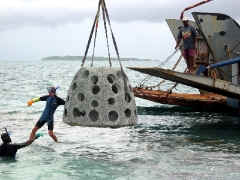Normally I stick to the light commercial/ residential energy consumer markets and grass roots environmental issues. This blog will occasionally address industrial issues especially involving large power generators. The Space Shuttle is so way past industrial that well it’s hard for this blog to comment. I am also very conscious of the 2 we collectively blew up. I lived through both of them and the fire aboard the Apollo 1 space flight testing. That said I think NASA needs to keep flying the Shuttles until they have an effective replacement for it. NASA argues that they don’t have the money or the manpower to do both. I think that is sissy talk myself. The Hubble needs them and so does the International Space Station. We are never leaving this solar system of ours. That’s a fact Jack. Even Asimov said it would take us 100 years to have the infrastructure in place to go to Mars so let’s slow down and get this one right. The first thing we need to do is create an integrated space command so that everyone is flying together.
We need to create reuseable space stuff too. Our orbit is starting to look like a flying garbage dump. We have our stuff scatterred willy nilly over 4 planets besides our own. We have even thrown something out into the galaxy. But throwing stuff away, like Burning Behavior will take several posts.
http://space.newscientist.com/article/dn15145-space-shuttle-is-key-issue-for-obama-agency-says.html
Space shuttle is key issue for Obama, agency says
- 22:48 06 November 2008
- NewScientist.com news service
- Rachel Courtland
Incoming president Barack Obama must decide the shuttle’s fate soon if he wants to keeps its replacement on schedule, the Government Accountability Office says (Image: NASA)
Related Articles
- Problems mount for NASA’s Ares rocket
- 28 October 2008
- What direction now for US space exploration?
- 03 October 2008
- Moonlighting engineers design alternative NASA rocket
- 21 July 2008
- Search New Scientist
- Contact us
Web Links
- Constellation, NASA
- Retirement of the space shuttle, GAO
- NASA’s post-shuttle prospects, Congressional Budget Office
US president-elect Barack Obama will need to decide soon whether to retire the space shuttle in 2010 or extend its life, a government oversight office said on Thursday.
The space shuttle is one of 13 ‘urgent’ issues that face the next US president, according to a US Government Accountability Office (GAO) list. “These are issues that will require the attention of the President and Congress early on in the next administration,” says GAO spokesperson Chuck Young.
Deciding the fate of the shuttle is particularly time-sensitive, Young says. If the government decides to fly more shuttle missions, it could impact how quickly NASA can move forward with a shuttle replacement, set to be ready to fly by March 2015.
The replacement, the centrepiece of a NASA programme called Constellation, would end a five-year gap in the US’s ability to transport astronauts to space. During the interim, astronauts will have to hitch rides to the International Space Station on Russian Soyuz capsules.
Interdependent programmes
Extending the shuttle’s lifetime means that if “NASA’s budget doesn’t change, it will put Constellation off”, says Cristina Chaplain of the GAO.
But even with more money, NASA may not be able to close the gap in its access to space. That’s because the shuttle and Constellation programmes are interdependent, Chaplain told New Scientist.
The agency needs to free up facilities and personnel that currently maintain the shuttle fleet for work on the replacement vehicle, an Apollo-inspired capsule called Orion that will launch atop the Ares I rocket.
Congress built in time for Obama to decide the shuttle’s fate. NASA is not allowed to take any actions before 30 April 2009 that would prevent the shuttle from flying safely after its scheduled retirement in 2010, according to the agency’s new authorisation act, which passed in October.
:}
Would you care to bet on that?:
http://www.hubdub.com/m21244/Will_the_Space_Shuttle_retire_by_the_end_of_2010_as_planned
Will the Space Shuttle
retire by the end of
2010, as planned?
Current forecast: 30% chance 
![]()
Combining all predictions, the current forecast is that this is 30% likely to happen (unchanged in last 1 day)
The addition of an extra mission to NASA’s space shuttle flight manifest could significantly reduce the chance of retiring the orbiter fleet in 2010 as planned, possibly to as low as 5 percent, the Congressional Budget Office (CBO) said in a report released Monday [Nov 3, 2008].
The CBO studied risks associated with delaying the space shuttle’s retirement and how that would affect work on the replacement system – consisting of the Orion Crew Exploration Vehicle and the Ares I launcher – which is expected to debut in 2015.
The report concluded there was a 20 to 60 percent chance NASA would be able to fly all of the 10 scheduled shuttle missions in the next two years. The addition of an 11th mission to transport the Alpha Magnetic Spectrometer to the space station, as Congress has directed, would reduce that probability to between 5 and 30 percent, the CBO report said.
:}
Then again the way the Orion and the Constellation are going they may have all the time in the world:
http://www.space.com/news/081104-nasa-shuttle-retirement-cbo.html
The gap between the shuttle’s retirement and the first flight of Orion and Ares I could widen if NASA cannot keep Orion’s mass from growing during development. Other issues that could delay Orion and Ares I include a longer-than-expected development of Ares I’s J-2X upper-stage engine, difficulties with the Orion’s heat shields and excessive thrust oscillation in Ares 1’s first stage, the CBO report said.
The report also said a $577 million reduction in NASA’s 2007 funding prompted NASA to forego some robotic lunar surface exploration missions, which could delay plans to return astronauts to the Moon by 2020.
The gap between the shuttle’s retirement and the first flight of Orion and Ares I could widen if NASA cannot keep Orion’s mass from growing during development. Other issues that could delay Orion and Ares I include a longer-than-expected development of Ares I’s J-2X upper-stage engine, difficulties with the Orion’s heat shields and excessive thrust oscillation in Ares 1’s first stage, the CBO report said.
The report also said a $577 million reduction in NASA’s 2007 funding prompted NASA to forego some robotic lunar surface exploration missions, which could delay plans to return astronauts to the Moon by 2020.
The gap between the shuttle’s retirement and the first flight of Orion and Ares I could widen if NASA cannot keep Orion’s mass from growing during development. Other issues that could delay Orion and Ares I include a longer-than-expected development of Ares I’s J-2X upper-stage engine, difficulties with the Orion’s heat shields and excessive thrust oscillation in Ares 1’s first stage, the CBO report said.
The report also said a $577 million reduction in NASA’s 2007 funding prompted NASA to forego some robotic lunar surface exploration missions, which could delay plans to return astronauts to the Moon by 2020.
http://www.space.com/common/media/video.php?videoRef=SP_080821_parchute_test
http://www.space.com/common/media/video.php?videoRef=SP_080721_constellation1
http://www.space.com/common/media/video.php?videoRef=SP_080721_constellation2
http://www.space.com/common/media/video.php?videoRef=080626-constellation-rock









